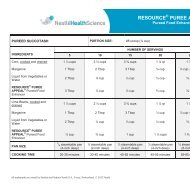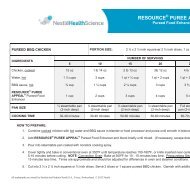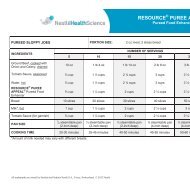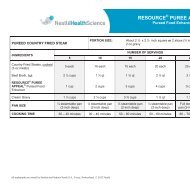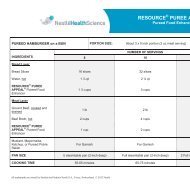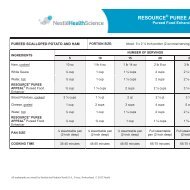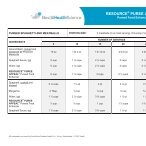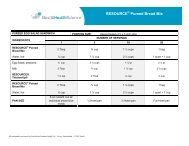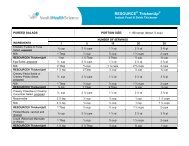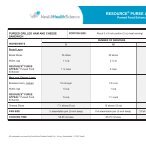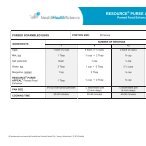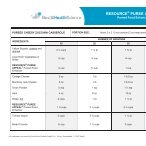Making Dysphagia Easier to Swallow - Dysphagia-Diet
Making Dysphagia Easier to Swallow - Dysphagia-Diet
Making Dysphagia Easier to Swallow - Dysphagia-Diet
- No tags were found...
You also want an ePaper? Increase the reach of your titles
YUMPU automatically turns print PDFs into web optimized ePapers that Google loves.
<strong>Making</strong> <strong>Dysphagia</strong><strong>Easier</strong> <strong>to</strong> <strong>Swallow</strong>The National <strong>Dysphagia</strong> <strong>Diet</strong> is 10 years old this year.by | Debbie Zwiefelhofer, RD, LDNo doubt, as long as man has walked the earth, someone—somewhere—has experienced difficulty in swallowing.As a condition, swallowing difficulty—or dysphagia—has been studied for decades. But as a condition requiring a specialized oral diet,dysphagia is just a “kid.” Prior <strong>to</strong> the 1970s, people unable <strong>to</strong> swallow were most often nutritionally managed by using enteral tubefeedings. Returning the individual <strong>to</strong> oral feeding was typically the goal, but healthcare professionals lacked a unified plan <strong>to</strong> get themthere. Fortunately for patients, healthcare professionals discovered that an active interdisciplinary approach <strong>to</strong> diagnosis, management, andrehabilitation techniques can help normalize the swallowing process. Improved swallowing often results in a return <strong>to</strong> normal eating, andthat serves <strong>to</strong> speed recovery and improve quality of life. It was the recognition of a lack of dysphagia diet standards and the value ofteamwork that ignited the creation of the National <strong>Dysphagia</strong> <strong>Diet</strong>: Standardization for Optimal Care.The concept of a National <strong>Dysphagia</strong> <strong>Diet</strong> (NDD) was conceived in the early 1990s as a way <strong>to</strong> decrease the confusion incommunications between healthcare professionals, patients, and caregivers. At the time, a survey with clinicians showed that more than 40different terms were used <strong>to</strong> label solid food textures, and at least 18 different names were used <strong>to</strong> describe liquid consistencies. This was themotivation behind forming a NDD Task Force of speech-language pathologists, dietitians, food scientists, and manufacturers that wouldcollectively begin <strong>to</strong> untangle cluttered dysphagia diet practices. The goal of the NDD was <strong>to</strong> standardize terminology and proceduresbased on best practices of the time.One step in developing the NDD was <strong>to</strong> seek a more scientific foundation for the dysphagia diet that would be based on key rheologicalproperties of foods and fluids. This foundation would help <strong>to</strong> create consistency across the food industry both in manufacturing andfoodservice operations. To be scientific; the food properties needed <strong>to</strong> be objective, measurable, and include all foods within the dietcontinuum. In the end, the diet needed <strong>to</strong> address both solid textures and liquid viscosities. And most importantly, the diet needed <strong>to</strong> besomething that could be transferred from facility services <strong>to</strong> at-home care. But what is food and fluid rheology and how does that relate <strong>to</strong>
eating? Food rheology is the science of identifying and measuring food textures. With an understanding of these textures it becomespossible <strong>to</strong> measure and relate any given food <strong>to</strong> the ability (or inability) <strong>to</strong> chew, manipulate and swallow that item. To summarize, thismeans that a diet for dysphagia is not as simple as puree, mince or chop - that is only one part of the matrix.Basic Forces of Chewing and <strong>Swallow</strong>ingTo understand the NDD, it’s important <strong>to</strong> understand thephysical forces of the chewing and swallowing process that mostpeople take for granted. Five basic effects result from the forcesthat occur during chewing and swallowing. See Figure 1The type of food will dictate which, and how much, of theseforces are needed <strong>to</strong> manipulate the item enough <strong>to</strong> enableswallowing it. For example, applesauce is much easier <strong>to</strong> eat ascompared <strong>to</strong> apple slices as compared <strong>to</strong> a whole apple.Food TexturesAny food can be defined by its textural characteristics. More thantwo dozen food textures have been identified, however, only eigh<strong>to</strong>f these textures are considered most significant in treatingdysphagia. Food textures share descriptions that are similar <strong>to</strong>those of chewing and swallowing.• Adhesiveness• Cohesiveness• Firmness• Biteability• Hardness• Springiness• Viscosity (applies only <strong>to</strong> liquids)• ShearLab instruments and software programs are used in food development and manufacturing <strong>to</strong> measure the texture dimensions of individualfoods. The NDD Task Force measured and analyzed more than 120 different foods <strong>to</strong> arrive at the NDD <strong>Diet</strong> Levels and where foods areassigned within each level. Figure 2 shows how foods can be plotted by a descriptive texture across a force continuum. To illustrate how<strong>to</strong> interpret the continuum, consider the example for ‘biteability’. It is very easy <strong>to</strong> bite a piece of a corn muffin. It takes such little effortthat front teeth can accommodate the bite. A graham cracker is only a little more difficult <strong>to</strong> bite. A ginger snap, however, is a firmcrunchy cookie that requires even more biting force than the cracker. As a food is more “biteable” we begin <strong>to</strong> shift it around from thefront teeth, which are designed for biting harder foods. Peanut brittle is “<strong>to</strong>oth breaking <strong>to</strong>ugh” and very difficult <strong>to</strong> bite <strong>to</strong> the degree thata person would rarely use front teeth for the bite, but rather shift <strong>to</strong> the stronger incisor teeth. Again, a person spends little timethoughtfully determining how <strong>to</strong> “attack” a food; the actions come naturally from years of experience in eating.
Translating Science <strong>to</strong> <strong>Diet</strong> PrescriptionPeople may have assumed that a group simply sat around a tableand arbitrarily decided the NDD diet levels and which foodsshould be assigned <strong>to</strong> each of those levels. The science and analysisdescribed here actually <strong>to</strong>ok much subjective choice out of theNDD development. The analysis clearly showed textural breakpoints between each of the NDD diet levels. While it was notpossible <strong>to</strong> scientifically analyze all the foods and foodcombinations that exist on menus, the data collected from thetested foods served as bench marks for categorizing similar typefoods in<strong>to</strong> diet levels as described in Figure 3a. A similar approachof measuring and analyzing viscosity and shear was used <strong>to</strong> definethickened liquids by assigning viscosity ranges as shown in Figure3b. This compilation of several years of work from the NDD taskforce represents <strong>to</strong>day’s National <strong>Dysphagia</strong> <strong>Diet</strong> standards.Putting the NDD in<strong>to</strong> PracticeSpeech- language pathologists (SLP) use a variety of <strong>to</strong>ols <strong>to</strong> assessan individual’s ability <strong>to</strong> chew and swallow safely and assign a dietlevel. Several evaluation methods [Figure 4] are available for aspeech- language pathologist <strong>to</strong> use in assigning dysphagia severity.None of the methods are a perfect match <strong>to</strong> the NDD; however,the severity scale most closely correlated <strong>to</strong> the NDD is the<strong>Dysphagia</strong> Outcome and Severity Scale (DOSS). The DOSS uses ascale of 7 (normal in all situations) <strong>to</strong> 1 (severe; unable <strong>to</strong> <strong>to</strong>lerateany oral intake safely). In lieu of other evaluation <strong>to</strong>ols, using theDOSS offers a fairly systematic way <strong>to</strong> match NDD diet level <strong>to</strong> thepatient as shown in Figure 5. A key take-away from this chartshould be that the dysphagia diet is a continuum, often times anindividual is starting the next level while still in the prior one.Rehabilitation Institute of Chicago Functional <strong>Swallow</strong>ing Scale(RIC-FSS)<strong>Dysphagia</strong> Severity Rating Scale for Parkinson’s DiseaseAmyotrophic Lateral Sclerosis (ALS) Severity ScaleThe <strong>Dysphagia</strong> Outcome and Severity Scale (DOSS)Implementing the National <strong>Dysphagia</strong> <strong>Diet</strong>The dysphagia diet is more than simply adjusting food texture.The diet is a critical <strong>to</strong>ol within someone’s <strong>to</strong>tal therapy plan <strong>to</strong>improve their quality of life. A small informal survey (done by thisauthor) from the fall of 2011 indicated that a little over 60% ofhealth care facilities use the NDD for guidance for their dysphagiadiet menu. This opens the question of what the other 40% ofhealth care facilities are providing for a dysphagia diet in their respective operation. Implementing the NDD does not have <strong>to</strong> be adaunting task, especially when it is approached with small goals. Most facilities have a “Wound Care Team”; consider creating the“<strong>Dysphagia</strong> Care Team”. Use a <strong>Dysphagia</strong> Care Team <strong>to</strong> review the ideas shown in the checklist, take inven<strong>to</strong>ry of current facility practiceand make a simple plan <strong>to</strong> move forward.
Checklist for Best Practice• Regularly meet as an interdisciplinary dysphagia team(medical direc<strong>to</strong>r, speech, nursing, dietary and others).• Review current menu, recipes and special dysphagiaproducts with the facility SLP <strong>to</strong> align diet objectives.• Challenge kitchen staff <strong>to</strong> do more with dysphagia dietplate presentations.• Train new facility hires about facility dysphagia dietstandards.• Annually retrain facility staff on the importance of thedysphagia diet standards.• Discuss implementing dysphagia-specific pro<strong>to</strong>cols(oral hygiene, hydration, satisfaction survey, etc.).• Provide discharge education for patients/caregivers (where applicable).What Next?Science and practice are rarely in sync and health care is often left <strong>to</strong> watching and waiting for the next new medicine, therapy, super foodor best practice. Few would argue that a time has come for the NDD <strong>to</strong> be refreshed. For <strong>to</strong>day, however, the National <strong>Dysphagia</strong> <strong>Diet</strong>:Standardization for Optimal Care represents the best information available <strong>to</strong> guide the dysphagia diet. Standards and best practices areuseful professional <strong>to</strong>ols because they offer guidance where all the answers may not yet be available. Not only does a good standard guidethe practitioner, it also is informative for the patient, caregivers, regula<strong>to</strong>rs and the greater public audience. Any facility that is not usingthe NDD as the standard for their dysphagia diets may create an opening <strong>to</strong> ethical and legal liability. Of most importance, individualsliving with dysphagia deserve <strong>to</strong> receive the most current standards of care, including those of the NDD. If your facility is still waiting <strong>to</strong>implement the National <strong>Dysphagia</strong> <strong>Diet</strong>, wait no longer – your clients are depending on you.Debbie Zwiefelhofer, RD, LD is the President for NutritionAffairs LLC, Minneapolis, MN. Visit www.NutritionAffairs.comor contact her at dznutrition@yahoo.comReferences1. Groher, M. <strong>Dysphagia</strong> Diagnosis and Management, 2ndEd. S<strong>to</strong>neham, MA: Butterworth-Heinemann, 1992.2. Logeman, J. Evaluation and Treatment of <strong>Swallow</strong>ingDisorders. Austin, TX: PRO-ED, 1983.3. National <strong>Dysphagia</strong> <strong>Diet</strong> Task Force. National <strong>Dysphagia</strong><strong>Diet</strong>: Standardization for Optimal Care. Chicago:American <strong>Diet</strong>etic Association (now Academy of Nutritionand <strong>Diet</strong>etics), 2002.4. Sonies, B. <strong>Dysphagia</strong>: A Continuum of Care. Maryland:Aspen Publishers, 1997.



